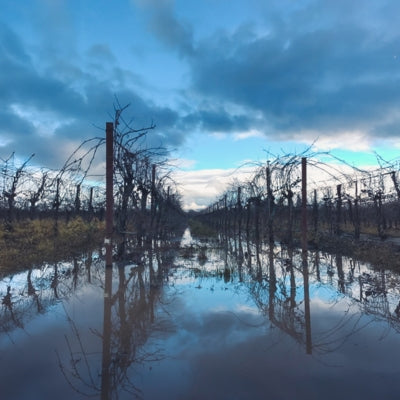
Vineyard threats: heavy rainfall & waterlogging
In the fourth part of our series on vineyard threats and the impact of extreme weather, Westgarth Wines wine specialist Maurizio Broggi looks at the problems caused by heavy rainfall.
The conditions for waterlogging
While drought stress poses a significant threat to grapevines, excessive rainfall during the growing season poses severely detrimental consequences, particularly in soils with poor drainage. This is especially true in mild, maritime climate regions prone to high levels of precipitation during the growing season.
The timing of heavy precipitation events plays a critical role in determining the severity of the impact on vines. During winter dormancy, vines exhibit a higher tolerance for waterlogged soils due to their reduced physiological activity.
During the growing season, however, when roots require adequate oxygen for optimal function, excessive soil moisture can lead to a number of negative consequences.
The impact of waterlogging
Oxygen availability
Waterlogged soils restrict root respiration by limiting oxygen availability, hindering root growth and development, and potentially reducing the vine's ability to withstand future drought stress and increasing the risk of mineral deficiencies.
Saturation
Saturated soils take longer to warm up in spring, potentially delaying bud break and vine growth. Excessive rainfall, particularly during the late spring and summer ripening period, can lead to overly vigorous vegetative growth at the expense of fruit quality. This disrupts the vine's natural balance between vegetative and fruit development, potentially delaying ripening and negatively impacting grape sugar accumulation and flavor profile.
Disease
High humidity levels associated with heavy rain events create favorable conditions for the proliferation of fungal diseases such as downy mildew and grey rot. These pathogens thrive in wet weather and can significantly reduce fruit yield and quality if left unchecked.
Physical damage
Heavy rainfall can also physically damage berries, particularly during rapid berry growth stages. The sudden influx of water can cause the berries to swell quickly, exceeding the capacity of their skins and resulting in splitting.
Dilution
Even if berry splitting doesn't occur, excessive rainfall just before harvest can dilute the sugar content of ripening grapes. As berries take up excess water, the sugar concentration within the juice becomes diluted, potentially leading to musts with lower sugar levels and wines with lower alcohol content and less flavor intensity.
Nutrient loss
Heavy precipitation can also contribute to the leaching of essential nutrients from the soil which can lead to deficiencies in vital elements required for optimal vine growth and fruit development.
Operational challenges
Finally, waterlogged soils create challenges for vineyard operations. The difficulty of accessing the vineyard with machinery and personnel for essential tasks such as pruning, canopy management, and disease control can be significantly hampered by wet soil conditions.
Preventative measures
While the weather is unpredictable and impossible to control, countermeasures can be implemented ahead of time where the threat of extreme rainfall is impending.
Soil management and drainage
Effective soil management, including subsurface drainage systems like tile drains, reduces waterlogging risks. Selecting rootstocks that are tolerant to wet conditions and incorporating organic matter to enhance soil structure and water infiltration can further protect vines from excessive rainfall.
Canopy management
Proper canopy management, such as leaf thinning and shoot positioning, improves air circulation and sunlight penetration, reducing the risk of fungal diseases. These practices ensure that vine vigor is balanced and do not overshadow fruit development.
Timing of vineyard activities
Timing vineyard activities strategically, like avoiding irrigation during expected rainfall and scheduling key operations in drier periods, helps minimize waterlogging and soil compaction. Monitoring weather forecasts also allows for timely fungicide application to protect against disease.
Cover cropping and ground cover management
Cover crops improve soil structure, reduce erosion, and enhance water infiltration, mitigating water accumulation around vines during heavy rainfall. Choosing cover crops that don’t compete excessively with vines ensures a balanced vineyard environment that contributes to good biodiversity.
Use of precision viticulture
Precision viticulture tools, like soil moisture sensors, offer real-time monitoring of vineyard conditions. These technologies enable informed decisions on irrigation and drainage, helping vineyard managers optimize strategies to combat excessive rainfall.
Planning ahead
Contingency planning for heavy rainfall can also include securing alternative machinery routes, stocking disease control materials, and preparing for harvest delays. Proactive planning allows vineyard managers to respond quickly to challenges from heavy rainfall.
In many cases, however, the seemingly more pragmatic measures are unavailable, for instance due to strict controls on organic viticulture or preservation of biodiversity.
Other measures must be taken far ahead of time which is not always possible. Given the constant evolution of terroir due to climate change and the desired longevity of a vineyard – stretching on for decades, if not centuries – consistency is often ephemeral.
Want to read more? Take a look at some of our other blogs:



